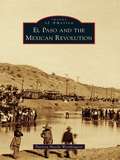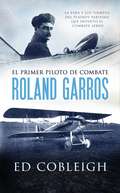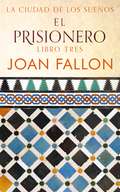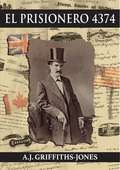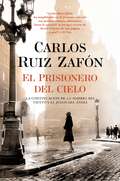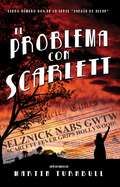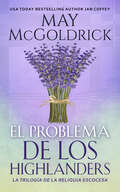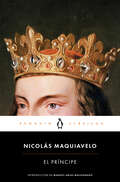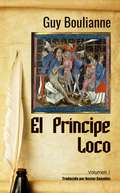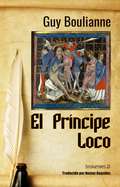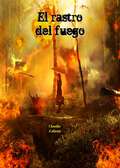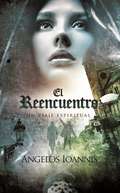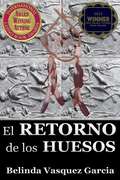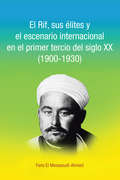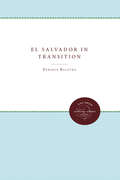- Table View
- List View
El Paso and the Mexican Revolution (Images of America)
by Patricia Haesly WorthingtonThe Mexican Revolution took place along the entire length of the border between the United States and Mexico. Most of the intense battles and revolutionary intrigue, however, were concentrated in the border region of El Paso, Texas, and Ciudad Juárez, Mexico. For 20 years, the U.S. and Mexico border communities dealt with revolution, beginning before the 1909 Taft-Díaz visit and ending with the Escobar Revolution of 1929. In between were battles, assassinations, invasions, and attempts at diplomacy. El Paso was center stage for many of these events. Newspapers and media from all over the country flocked to the border and produced numerous stories, photographs, and colorful renditions of the Mexican Revolution. The facts and myths have been kept alive over the last 100 years, and the revolution remains an important topic of discussion today.
El Pirata (La ciudad de los sueños #2)
by Joan FallonAmbientado en la Málaga del S. XI, El Pirata es el segundo libro de la trilogía La Ciudad de los Sueños. Esta emocionante y excitante novela histórica lleva al lector a un mundo medieval de mercaderes y marinero que navegan en la costa occidental del Mediterráneo y los piratas que los aterrorizan. Temprano por la mañana el capitán pirata, al-Awar, hace una incursión relámpago en el astillero de Málaga y secuestra a Bakr, el maestro constructor naval, y dos de sus trabajadores. Antes de que nadie pueda hacer nada al respecto, han desaparecido. Nadie tiene ni idea de por qué los piratas se los han llevado o de a dónde han ido, pero todo el mundo está de acuerdo en que un solo destino les aguarda: la muerte o la esclavitud. Cuando la mujer de Bakr recibe la noticia, se queda destrozada, pero se niega a escuchar a los que dicen que hay poca esperanza de encontrar a su marido con vida. En lugar de eso está decidida a descubrir dónde se lo han llevado los piratas. Con todo el Mediterráneo para esconderse, encontrar a los hombres secuestrados parece una misión imposible, pero se niega a darse por vencida y alienta a su familia y amigos a buscarlo. En el centro de esta novela está la tierna historia de amor de Aisha y Bakr y los profundos sentimientos que se profesan. Es pensar en ella lo que le ayuda a mantenerse con vida mientras está en cautividad con pocas perspectivas de ver su casa y su familia de nuevo, y es su amor por él lo que le proporciona a ella fuerzas para no abandonar la esperanza de traerlo de nuevo a casa.
El Primer Piloto de Combate: Roland Garros
by Ed CobleighLa primavera de 1915, un playboy parisino se convirtió en el primer piloto de combate del mundo. Nunca antes un piloto solitario había cazado a otros aviadores. Roland Garros libró ilimitados combates aéreos, cambiando para siempre la guerra. Antes de abandonar la sociedad francesa del café para ir a la Primera Guerra Mundial, el joven piloto estableció récords de aviación, ganó carreras aéreas e introdujo el vuelo más pesado que el aire a las multitudes emocionadas en los Estados Unidos, Europa y América Latina. Voló como explorador para el Ejército de los EE.UU., paseó como Boulevardier, vendió autos deportivos, tocó el piano clásico, fue abogado, ciclista profesional y atleta de clase mundial. El piloto pionero de La Belle Époque descendió al infierno artificial de la Gran Guerra. Derribado y capturado, escapó, regresó a París y a los brazos de una bailarina exótica que le esperaba antes de regresar al cielo. La emocionante vida y los fascinantes tiempos de Roland Garros tejen una historia fascinante. Esta biografía narrativa de no ficción ofrece esa crónica emocionante y objetiva.
El Prisionero (La Ciudad de los Sueños #3)
by Joan FallonEl libro 3 de la trilogía la Ciudad de los Sueños retoma la historia del príncipe moro que fue encerrado en prisión por su hermano, el nuevo califa de Málaga. Un periodo inestable en la historia de la España mora que se hace mucho más turbulento a media que intrigas y traición en la casa real amenazan la estabilidad de la ciudad. En este contexto, la prima de Makoud y su familia llegan a Málaga, esperando cumplir sus sueños y labrarse una vida propia, pero tienen secretos que si se descubren podrían suponer enfrentarse al exilio o a la muerte. El Prisionero es una historia trepidante de aventuras y romances ambientada en la exótica y vibrante Málaga del siglo XI.
El Prisionero 4374
by A.J. Griffiths-JonesDurante más de un siglo, el Dr. Thomas Neill Cream fue un potencial sospechoso de ser Jack el Destripador. Era un personaje siniestro, que se alimentaba de las almas desafortunadas que se veían obligadas a ganarse la vida como prostituta en el Londres victoriano, y que finalmente llevó a esas pobres mujeres a una muerte prematura y tortuosa. Estos crímenes finalmente lo señalaron como el "Envenenador de Lambeth". Sin embargo, durante la época de los atroces asesinatos del Destripador, el Dr. Cream fue encarcelado en la prisión de Joliet, Illinois. A lo largo de las décadas, este hecho por sí solo ha causado un debate sobre si merece o no estar bajo sospecha de ser el demonio de Whitechapel. ¿Era posible que el Dr. Cream sobornara para salir de la cárcel, quizás usando a un doble para tomar su lugar mientras secretamente encontraba un pasaje a Inglaterra con intenciones de asesinar? Este fascinante libro, contado desde el punto de vista del propio Cream, explica la retorcida lógica detrás de sus acciones. El autor ha hecho una considerable y meticulosa investigación, siguiendo la vida de Cream desde su adolescencia en Canadá hasta sus últimos momentos en la horca en Newgate.
El Prisionero del Cielo
by Carlos Ruiz ZafónBarcelona, 1957. Daniel Sempere y su amigo Fermín, los héroes de La Sombra del Viento, regresan de nuevo a la aventura para afrontar el mayor desafío de sus vidas. Justo cuando todo empezaba a sonreírles, un inquietante personaje visita la librería de Sempere y amenaza con desvelar un terrible secreto que lleva enterrado más de dos décadas en la oscura memoria de la ciudad. Al conocer la verdad, Daniel comprenderá que su destino le arrastra irremediablemente a enfrentarse con la mayor de las sombras: la que crece en su interior. Rebosante de intriga y emoción, El Prisionero del Cielo es una novela magistral donde los hilos de La Sombra del Viento y El Juego del Ángel convergen a través del embrujo de la literatura y el enigma que se oculta en el corazón del Cementerio de los Libros Olvidados.
El Problema con Scarlett
by Martin Turnbull Gabriela Garcia CalderonEs 1936 - Se lanza a la venta Lo que el viento se llevó, primer libro de la autora Margaret Mitchell y se convierte en un éxito internacional. De repente todo el país está obsesionado con responder una sola pregunta: ¿quién ganará el rol de Scarlett O'Hara? Verano de 1936: Lo que el viento se llevó, la primera novela de Margaret Mitchell, ha cautivado al mundo. Todos saben que las películas sobre la Guerra Civil no ganan dinero, pero el productor renegado David O. Selznick adquirió los derechos de la película y de repente en Estados Unidos solamente hay una pregunta: ¿quién será Scarlett O'Hara? Cuando Gwendolyn Brick pone la manos en el libro, las nubes se abren y los ángeles cantan el coro del Aleluya. Solamente una belleza sureña puede ser Scarlett--¿y acaso su mamá no la crió con historias de la marcha de Sherman y los malditos yanquis? Después de vender cigarrillos en el Cocoanut Grove, Gwendolyn encuentra un nuevo llamado: representar a Scarlett. Pero no es la única chica en la ciudad con un acento muy sureño. Va a tener que destacar más que una falda en una parrillada de Twelve Oaks para conseguir ese papel. Marcus Adler es el chico mimado de Cosmopolitan Pictures, el estudio William Randolph Hearst inició para su amante, Marion Davies. Cuando el guion de Marcus se convierte en el primer éxito de Davies, lo invitan a pasar el fin de semana en el Castillo Hearst. El chico al que botaron de Pennsylvania se codea con Myrna Loy, Winston Churchill y Katharine Hepburn--pero cuando el viaje se vuelve un fracaso, empieza a hundirse rápidamente. Necesita una nueva historia, de verdad grande y muy rápido. Así que cuando F. Scott Fitzgerald se muda el Garden of Allah con un contrato de mil dólares a la semana con MGM pero sin idea de cómo escribir un guion, Marcus dice: "Encantado de conocerlo. Tenemos que hablar". Cuando Selznick le píde a George Cukor que dirija Lo que el viento se llevó, es l
El Problema de los Highlanders: La Trilogía de la Reliquia Escocesa (La Trilogía de la Reliquia Escocesa)
by Jan Coffey May McGoldrickEn el corazón de Escocia, un guerrero de las Highlands está a punto de encontrar a su pareja... En una tierra donde la magia se entreteje entre antiguas piedras y los susurros de criaturas legendarias resuenan en las brumosas cañadas, Alexander Macpherson, un formidable guerrero de las Highlands, se enfrenta a su mayor desafío hasta la fecha: ha perdido el rastro de su encantadora esposa. Cuando aceptó tomar por esposa a la indomable Kenna MacKay para fortalecer el dominio de su clan en el norte, esperaba un período de adaptación. Lo que no esperaba era que la fogosa joven huyera en plena noche de bodas, dejando tras de sí un rastro de misterio y nostalgia. Kenna MacKay creía haber hallado refugio entre los sagrados muros de un priorato, perfeccionando sus habilidades en las místicas artes de la curación. Pero el destino tiene otros planes. Secuestrada por su propio marido, es empujada de nuevo a un mundo donde las chispas vuelan y los temperamentos chocan. A medida que la apasionada batalla de voluntades se reaviva, también lo hace un amor tan profundo y salvaje como los lagos de las Highlands. Pero las sombras del pasado de Kenna resurgen, cargadas de un secreto mortal que amenaza con destruir su floreciente romance. Con un villano despiadado cada vez más cerca, Alexander y Kenna deberán encontrar el coraje para enfrentar sus miedos más oscuros. Solo juntos, ejerciendo el poder de un amor eterno, podrán resistir las fuerzas que intentan separarlos. Esta vez, Alexander está decidido: no volverá a perder a su novia mágica.
El Príncipe
by Nicolas MaquiaveloUn tratado imprescindible sobre estrategias y ambiciones políticas escrito por el padre de la ciencia política moderna Introducción de Manuel Arias Maldonado Traducción y notas de Mauro Armiño Mientras los seres humanos convivan, será necesaria la política. Maquiavelo, que lo sabía por su experiencia en el gobierno de la Florencia renacentista, escribió este tratado para analizar el modo en que los gobernantes consiguen el poder y lo conservan. Con ejemplos históricos, expone una filosofía política en la que el valor de las acciones se define a partir de su eficacia, inaugurando un realismo que se aleja de las corrientes moralistas y utópicas de su época. La presente edición ofrece una nueva traducción anotada de Mauro Armiño, realizada a la luz de las mejores ediciones y más recientes italianas; se abre con una brillante introducción a cargo del escritor y politólogo Manuel Arias Maldonado en la que se defiende la relevancia del texto en nuestros días.
El Príncipe Loco (Volumen #1)
by Guy BoulianneEste es el primero de una serie de libros que relatan hechos históricos a menudo olvidados o desconocidos por el público en general, hechos históricos relacionados con nombres, fechas, eventos y simbolismos que difícilmente pueden ser refutados. Como dice el dicho: "La fuerza de vida sagrada, invisible y poderosa, contiene la memoria del pasado y la visión del futuro. Permite que la creación se manifieste en la materia aquí y ahora ". Durante años, Guy Boulianne ha estado investigando la memoria colectiva y la memoria de su ser, con el fin de restaurar una verdad enterrada en lo más profundo en sí misma y en las profundidades de los recuerdos humanos. Capítulo tras capítulo, como un diario, lleva al lector en su Búsqueda del Grial y le da las claves para una mejor comprensión del mundo pasado, presente y futuro. Con él, la historia secreta de Francia resurge y se transporta a esta tierra de bienvenida que es la Nueva Francia. A lo largo de las páginas, el autor siempre restaura un poco más la historia de su familia, que tiene su origen en los tiempos más remotos y se remonta al príncipe Ursus, descendiente del rey merovingio Dagobert II, de la princesa visigoda Gisèle de Rhedae. y el exilarca Makhir ben Habibaï, representante del poderoso judaísmo babilónico. Esta marca de nobleza está inscrita en el escudo de armas de la familia: "Azul con una pata de un oso dorado, puesto en una banda". Al igual que Arthur en su destreza, con la espada Excalibur en la mano, Guy Boulianne separa a los dragones, -guardianes de los tesoros- y comparte con usted la médula fundamental de su investigación.
El Príncipe Loco (Volumen #2)
by Guy BoulianneEste libro de Guy Boulianne es una colección de textos escritos y publicados en su sitio web entre los meses de junio de 2016 y enero de 2017. Es el seguimiento al primer volumen que introduce al lector en su búsqueda personal, tanto espiritual como histórica. Desde la misteriosa Francia hasta los orígenes de su familia, el lector podría seguirlo en sus descubrimientos, que compartió sin restricciones. En este nuevo libro, el autor se centra en aclarar los orígenes de sus antepasados. Desde el vizconde de Nîmes Ursus hasta el capitán de la milicia Jean-Marc de Bouillanne, a través del magistrado Paul Boyer de Bouillane, regresa el curso de la historia y logró vincular fechas, lugares y eventos para hacer un todo consistente. Ahora quiere ir más allá mediante el análisis de ADN-Y, junto con el análisis autosómico del ADN, para demostrar si la familia de Bouillanne está o no vinculada por la sangre a las familias de Planta y Planta de Wildenberg. De hecho, las dos familias vivían en las mismas regiones, es decir, el Dauphiné en Francia y Suiza, participaron en la Asamblea de Vizille en 1788, que precede la Revolución Francesa, y poseen las mismas caracteristicas en sus respectivos escudos, la pata del oso. El genealogista del ADN Jean-Pierre Gendreau-Hétu le escribió: "¡Espero que esta experiencia tenga éxito! ¡Podrías establecer con éxito una de las firmas más antiguas de ADN-Y conocidas en Francia hasta la actualidad! " "Conócete a ti mismo" es el precepto que está grabado en la entrada al Templo de Delphes. Guy Boulianne persigue incansablemente su búsqueda del grial que revelará los secretos enterrados bajo las velas del tiempo. El autor nos invita a seguirlo por este camino.
El Ranchero Contrata A Una Cocinera
by Misty M. BellerCuando la Guerra Civil obliga a una bella muchacha del Sur a un rancho de ganado rudo en Texas, el amor es lo último que espera encontrar. Cuando su hogar en Carolina del Sur se quemó hasta los cimientos, la única opción de Anna Stewart es mudarse con su hermano menor a las tierras salvajes de un rancho de Texas. Sus perspectivas están empezando a verse mejor, hasta que el hijo del ranchero, Jacob O'Brien, aparece con sus ojos alarmantemente azules para poner un tic en los planes bien controlados de Anna. Cuando el peligro se acrecienta a causa de una banda de ladrones de ganado con intenciones mortales, ¿puede Anna evadir el control de las manos capaces de Dios ... y las del vaquero de ojos azules que le ha robado el corazón?
El Ranchero Contrata a una Vaquera
by Misti M. BellerGrace Harper está escondida. Cuando su padre murió seis meses antes, nunca imaginó que su herencia inesperada amenazaría su vida. ¿Qué mejor lugar para desaparecer que en un rancho ganadero, haciendo el trabajo en el que pasó los últimos nueve años ayudando a su padre? Y seguramente estará a salvo escondida en Texas, a miles de kilómetros de su problema. Monty Dominguez ha pasado gran parte de su vida trabajando en Double Rocking B Ranch en Seguin, Texas. Ha pasado de ser un niño de cuadra huérfano de 12 años a capataz de rancho y amigo de confianza de la familia. No hay mucho que no haría para proteger a la gente y la tierra que ama, incluso si eso significa renunciar a sus propios sueños. Cuando el peligro que acecha a Grace la alcanza, solo hay una forma de salvar a la gente, especialmente al hombre, que ha llegado a amar. ¿Podrá encontrar el coraje para el máximo sacrificio para proteger a aquellos a los que ha puesto en peligro? Así como los sueños de Monty podrían finalmente estar a su alcance, ¿un paso en falso le costará todo? De un autor más vendido de USA Today llega una novela romántica histórica cristiana llena de aventuras y un feliz para siempre que te hará desmayar.
El Rastro del Fuego: de Notre Dame a la Mole Antonelliana.
by Claudio CalzoniEl Rastro del Fuego de Claudio Calzoni El Rastro del Fuego: de Notre Dame a la Mole Antonelliana. Hay una estela de fuego detrás de la muerte de tantas personas, la destrucción de monumentos que custodian la memoria de la Humanidad y una reliquia, la más importante que la cristiandad ha conservado durante milenios. El juego de ajedrez entre el Bien y el Mal ha comenzado. Los jugadores mueven sus piezas. Ganará el que ponga en jaque al Rey. No es fácil de encontrar pero el rastro del Fuego está en el aire...
El Reencuentro
by Angelos Ioannis Chanel Karime Otero AmadoFrente a la decisión de cambiar, todo mundo se siente débil. En el imperio veneciano del siglo 17, Mikhaela, una joven en sus veintes, se enfrenta a un desafío. Al conocer a un joven veneciano, Alessio, inmediatamente comprende que él representa mucho más que un simple encuentro en su vida. Al llegar a su vida sin ser invitado, o quizá subconscientemente si lo haya sido, le muestra, por medio del amor, una manera de cambiar, renacer y un reencontrarse con su verdadero ser. La lleva a través de un viaje de preguntas, preguntas enterradas profundo en su alma que despiertan con su incapacidad de detenerlas y finalmente la llevan a la decisión final: ¿Qué está haciendo con su vida? A través de sus palabras, Alessio la acompaña en un viaje interior, hablándole sobre el estado de Ser, y la lleva frente al oscuro túnel de lo desconocido, con una luz brillando al otro extremo, sólo vista por los valientes que pueden cruzarlo sin miedo. Y ahí se enfrenta a la decisión: ¿Entrar en él, dejar todo atrás y comenzar su viaje hacia la luz, o permanecer en la mediocre certeza del presente? Al vivir una vida de mediocridad, de rutina y al enfrentarse a un matrimonio cercano, tiene que decidir: ¿Ser o convertirse? Tiene que decidir entre lo normal, lo común, lo que le dicen sus padres, sus amigos y la sociedad o lo extraordinario, lo imposible, lo que su alma anhela. Tiene que decidir entre su actual pareja, su futuro esposo, o él hombre frente a ella, a quién su corazón desea. Es un libro dedicado a la decisión. A través de cuatro estaciones, este libro acompaña al lector a través del círculo de la vida, un círculo de preparación, de satisfacción, de recuerdos y de vacuidad, las cuatro estaciones que ocurren una tras otra en la vida, comenzando y concluyendo no después de cierto periodo de tiempo, sino después de ciertos eventos. El reencuentro es un viaje al origen, en el que la humanidad fue participe al
El Refugio De Darcy
by Abigail Reynolds Mara Doménech De SeingaltSe trata de una variación de la novela escrita por Jane Austen, 'Orgullo y prejuicio', por la escritora Abigail Reynolds quien a escrito otras variaciones de esta novela. Una fascinante variación con un sorprendente e intrépido desarrollo de la historia, originalmente escrita por Austen, y un final no menos inesperado. Una novela bien trazada, que enlaza los acontecimientos de forma magistral y que sin duda engancha como lo puede hacer cualquier libro de Jane Austen.
El Regalo de Lyon
by Tanya Anne Crosby Elisa PedrazConocido como el Lyon por su destreza en el campo de batalla, Piers de Montgomerie acepta un desafío del rey David; sofocar una molesta rebelión de las tierras altas. Como pago, acepta un terreno que está en disputa, sin embargo pronto descubrirá que lo que realmente desea es la belleza proveniente de las tierras altas, cuyos hermanos nunca doblegarán ante él. Meghan Brodie se niega a ser el peón en un juego político y jura no ser ganada tan fácilmente. Se resiste al Lyon inglés... pero incluso cuando comienza a darse cuenta de que su amor está destinado a sanar una tierra herida, no se atreverá a desear que Lyon vea más allá de la belleza física y ame a la chica imperfecta que hay dentro.
El Retorno de los Huesos: Inspirado en una verdadera historia de nativos americanos
by Belinda Vasquez GarciaEl Retorno de los Huesos, inspirada en una historia verídica, ganó el premio a la Mejor Novela de Ficción Histórica en los Premios para Libros de Nuevo México/Arizona y el premio al Mejor Ebook en los Premios Internacionales de Libros Latinos. Una deslumbrante historia épica de antepasados, amor y perdón. Acompaña el viaje de los últimos dos miembros del Pueblo de Pecos en su aventura para traer de vuelta los huesos de sus ancestros hacia las ruinas del pueblo de su familia. Los 2.067 esqueletos habían sido exhumados de su lugar de descanso 83 años atrás. En la actualudad y a través de las millas, el viento acarrea sus lamentos hacia el Abuelo, que oye a los huesos anhelar su hogar. Mujer Vacía y el abuelo son los últimos del Pueblo de Pecos, pero Mujer Vacía no está interesada en antiguos esqueletos familiares. Trabaja en un casino indígena y es una mujer moderna, mientras que el Abuelo es un chamán y valora la tradición. Ella espera que el viaje repare sus corazones rotos. El Abuelo construye un atrapasueños mágico para ayudar a Mujer Vacía a experimentar la vida de sus ancestros, arrojándola hacia el pasado, para que su nieta pueda amar a los huesos desaparecidos.
El Retrato
by Joan WolfEl padre de Isabel Besson es dueño de un circo ecuestre francés en el que ella creció, recorriendo Francia y actuando con su brillante caballo, Alonzo. Entre el público, durante una presentación en Londres, está Leo Sommers, conde de Camden, que se queda atónito al ver en Isabel la réplica de su famosa bisabuela cuyo retrato cuelga en su salón. Esto no es una coincidencia, ya que pronto sale a la luz que Isabel había sido secuestrada cuando era una bebé, y adoptada por “Papa” y su esposa cuando una mujer inglesa intentó venderles la bebé. Isabel no está interesada en conocer a su familia biológica, pero cuando se entera de que su padre biológico, el conde de Mansfield, le ha dejado una gran cantidad de dinero, Isabel ve un medio para que su papá se retire de la vida circense; y durante un verano ella se dirige a Camden Hall para demostrar su derecho a la herencia. Camden Hall es una de las grandes casas de Inglaterra y todo en ella se siente ajeno a Isabel. Echa de menos a su papá, el circo, Francia… todo de la vida que conoce. No le gusta su nueva familia: Lady Augusta, la tía anciana de Leo que siempre la corrige; el primo de Leo, Roger, que la llama “chica de circo” y la desnuda con los ojos; su propio hermano Henry, conde de Mansfield, que no quiere entregarle el dinero de su padre. Hay una persona en Camden Hall a quien Isabel llega a amar… el conde de Camden, y él siente lo mismo por ella.
El Rif, sus élites y el escenario internacional en el primer tercio del siglo XX (1900-1930)
by Faris El Messaoudi-AhmedUn libro que nos narra las grandes acontecimientos históricos que tuvieron lugar en el Rif marroquí en el Primer Tercio del siglo XX(1900-1930). El tema gira sobre las élites rifeñas y las estructuras socio-políticas en el Rif en el primer tercio del siglo XX. Recuperamos así el interés primero que guio el planteamiento de este trabajo como una tesis sobre la historia social. Un interés que se redefinirá a lo largo del tiempo para acabar en el campo del debate entre historia y memoria, el resultado final de esta evolución interna de la investigación es una aproximación a la forma en que se construye la memoria histórica. Además entre otros rasgos de identidad está el hecho que en su historia se presentan momentos importantes de interacción con occidente, lo que ha permitido crear un imaginario colectivo que contiene estas referencias, vinculada sobre todo a España en diversas etapas históricas y en menor a Francia entre otros países. Parte de ese imaginario es el que ha considerado el territorio marroquí, como un punto de unión entre occidente y oriente, aspecto que tendrá su propia presencia en los discursos justificadores del tema objeto de estudio. Se trata de una región, un espacio socio-histórico donde el análisis de los acontecimientos que aquí se describen son uno más del proceso modernizador en el que se hallan inmersos las sociedades arabo-islámicas. ¿Pero cómo entender la idea de la modernidad en una sociedad arabo-islámica? La cuestión planteada nos condujo a la necesidad de definir las líneas fundamentales en torno a la conciencia del tiempo y su reflejo en la historia. El planteamiento de estas consideraciones nutre la elaboración de los primeros capítulos y establece líneas de continuidad con el resto; por otro parte recorreré la historia contemporánea de Marruecos, aunque de una forma muy resumida, ya que es una necesidad formal cuyo fin es intentar rellenar las ausencias históricas que la mayoría de las personas tienen en lo que respecta a esta parte del mundo.
El Ritual de Aniversario: Un misterio de Judah P. Benjamin-Horatio Burdette
by Howard DensonDescripción del libro: Horatio T. Burdette, un ex esclavo que ahora vive en Chartres, Francia, recuerda cuando era un niño en Mississippi y finalmente ganó en un juego de blackjack el senador de Luisiana Judah P. Benjamin. Un apostador antiesclavista no sabía qué hacer con un sirviente con la clavícula rota, pero, cuando el Capitán Eagleton se está muriendo por envenenamiento en la Plantación Omega, manipuló las cartas para que el joven Horatio tuviera un futuro digno. Años antes, en la plantación Burdette, lo obligaron a permanecer en el aula mientras el tutor de los niños Burdette intentaba enseñarles Shakespeare, francés, retórica, etc. Irónicamente, Horatio terminó absorbiendo el conocimiento que los niños Burdette despreciaban. Otras tres muertes por envenenamiento ocurren en Omega Plantation, y Benjamin, con la ayuda de Horatio, puede evitar que los esclavos de la casa sean apresurados a veredictos rápidos. Benjamin continúa su viaje a la ciudad de Washington pero deja a Horatio en manos de personas en las que puede confiar. Cuando están en Nueva Orleans y luego en Chicago y Filadelfia, el Senador y Horatio recogen suficientes pistas para resolver el misterio de los envenenamientos en Omega Plantation.
El Sacramento: Edición 10° aniversario
by Fernanda PérezAventura, pasión y enfrentamientos sacuden esta clásica novela de Fernanda Pérez, en una edición especial por su décimo aniversario que incluye dos nuevos cuentos inéditos -referidos a personajes del libro- como regalo para las lectoras. El puerto de Colonia del Sacramento, en Uruguay, es disputado por portugueses y españoles. Estamos a finales del siglo XVIII, en plena época colonial, y la vida de las familias que allí habitan empieza a ser muy complicada. Es el caso de los Gonçálvez y Acuña, un padre de salud delicada que se destaca como comerciante y sus tres hijas, quienes están preocupadas por su futuro. Francisca, Catalina y Teresa, huérfanas de madre, tienen que ingeniárselas para que los distintos intereses de los europeos, pero también de los criollos, no arrasen con su integridad y su modo de vida. En un contexto que implica la relación cotidiana con esclavos, contrabandistas, militares y gente de campo, las hermanas despliegan sus dotes de seducción, valentía e inteligencia para sobrevivir y atravesar momentos difíciles. En el camino se encontrarán con el atractivo y ambicioso capitán Fernando Barrantes, el enigmático Amaro y el inolvidable Toribio, que sueña con cambiar las estrictas reglas sociales de la época.
El Salvador in Transition
by Enrique A. BaloyraBaloyra argues that the deepening American involvement in what is basically a domestic conflict between Salvadorans has failed to eliminate the obstructionism and violence of the Originally published in 1982.A UNC Press Enduring Edition -- UNC Press Enduring Editions use the latest in digital technology to make available again books from our distinguished backlist that were previously out of print. These editions are published unaltered from the original, and are presented in affordable paperback formats, bringing readers both historical and cultural value.
El Secreto de la señorita Sinclair: Libro 4 de la serie Secreta.
by Amylynn BrightAnna Sinclair es una inglesa que se niega a asentarse; no si todas sus amigas han encontrado el amor. Cuando recibe un mensaje diciendo que su padre, el general Sinclair, está perdido y se lo presume muerto en América poco después de la guerra de 1812, sabe que no tiene nada que perder yendo a buscarlo. En un país salvaje, tendrá que navegar por el río Mississippi, atravesar kilómetros de bosque, terremotos, indios y un capitán americano absurdamente atractivo. Nathaniel Johnson es un patriota americano cuyo único objetivo es volver al país que ama con su hermano recién encontrado, un marinero reclutado a la fuerza por los británicos. El dinero que se le ofrece por escoltar a una joven inglesa hasta Estados Unidos es demasiado para ignorarlo, más aún cuando está desesperado por salvar el imperio naviero de su familia. La hermosa dama cuenta una ridícula historia sobre estar buscando a su padre, pero Nate tiene razones convincentes para creer que es una espía de la Corona. La ayudará en su misión, al menos hasta poder probar sus intenciones malignas. ¿Podrá el secreto de Anna destruir su país y ser su ruina?
El Secreto del Duque de Morewether: Libro 3 de la Serie Secretos
by Amylynn BrightThea Ashbrook llega a Londres con la misión de hacer lo correcto con sus medio hermanos—no de encontrar marido. Nostálgica de Grecia, provoca un incidente en un salón de conferencias sobre arquitectura griega donde le presentan al molesto y guapo Duque de Morewether. Los chismes le han contado todas las aventuras escandalosas por las que él es tan famoso, y ella no está impresionada. Cuando descubre que su amor por la familia refleja el suyo, se da permiso para abrirle su corazón. Christian, duque de Morewether, es famoso por sus formas escandalosas. Piensa que a su vida no le falta nada, hasta que conoce a la señorita Althea Ashbrook y, por primera vez en su vida, se encuentra con la lengua trabada. Cuando su pasado regrese para perseguirlo, se necesitarán todos sus poderes de persuasión para convencer a Thea de que es digno de su amor. El duque tiene un secreto—uno que Thea cree que nunca podría perdonar y la envía corriendo a casa. Para encontrar la redención y recuperarla, Christian debe darse cuenta de que los errores no se pueden ignorar para siempre. Los secretos que guardas pueden cambiar tu vida para siempre.
